PF-04217903
This product is for research use only, not for human use. We do not sell to patients.

For small sizes, please check our retail website as below: www.invivochem.com
| Size | Price | Stock |
|---|---|---|
| 500mg | $1150 | Check With Us |
| 1g | $1750 | Check With Us |
| 5g | $4430 | Check With Us |
Cat #: V0603 CAS #: 956905-27-4 Purity ≥ 98%
Description: PF-04217903 (PF04217903) is an orally bioavailabe and ATP-competitive small-molecule inhibitor of the tyrosine kinase c-Met with potential antitumor activity.
Top Publications Citing Invivochem Products
Publications Citing InvivoChem Products
Product Promise

- Physicochemical and Storage Information
- Protocol
- Related Biological Data
- Stock Solution Preparation
- Quality Control Documentation
| Molecular Weight (MW) | 372.38 |
|---|---|
| Molecular Formula | C19H16N8O |
| CAS No. | 956905-27-4 |
| Storage | -20℃ for 3 years in powder formr |
| -80℃ for 2 years in solvent | |
| Solubility In Vitro | DMSO: 5 mg/mL (13.4 mM)r |
| Water: <1 mg/mLr | |
| Ethanol: <1 mg/mL | |
| Solubility In Vivo | 1% DMSO+30% polyethylene glycol+1% Tween 80: 30 mg/mL |
| SMILES Code | OCCN1N=CC(C2=CN=C3C(N(CC4=CC=C5N=CC=CC5=C4)N=N3)=N2)=C1 |
| Synonyms | PF04217903; PF4217903; PF-4217903; PF 04217903; PF-04217903; PF 4217903 |
| Protocol | In Vitro | PF-04217903 also inhibits HGF-mediated cell migration and Matrigel invasion in several c-Met–overexpressing tumor cell lines such as human NCI-H441 lung carcinoma and HT29 colon carcinoma with IC50 values comparable with those for inhibition of c-Met phosphorylation in these cell lines (IC50=7-12.5 nM). PF-04217903 (1.5-3333 nM; 48 hours) induces apoptosis of GTL-16 cells (IC50=31 nM). PF-04217903 (0.1-10000 nM; 48-72 hours) inhibits proliferation of c-Met–amplified human GTL-16 gastric carcinoma and H1993 NSCLC cells with IC50 values of 12 and 30 nM, respectively. |
|---|---|---|
| In Vivo | PF-04217903 (5-50 mg/kg, p.o.; once daily for 3 days) dose dependently inhibits c-Met, Gab-1, Erk1/2, and AKT phosphorylation and induced apoptosis (cleaved caspase-3) in U87MG xenograft tumors at all dose levels. PF-04217903 phenolsulfonate shows a significant dose-dependent reduction of human IL-8 levels in both the U87MG and GTL-16 models and decreases human VEGFA levels in the GTL-16 model. PF-04217903 strongly induces phospho-PDGFRβ levels in U87MG xenograft tumors. PF-04217903 (1-30 mg/kg; p.o.; daily for 16 days) shows dose-dependent tumor growth inhibition, which correlated with the inhibition in c-Met phosphorylation in these tumors. |
These protocols are for reference only. InvivoChem does not
independently validate these methods.
| Solvent volume to be added | Mass (the weight of a compound) | |||
|---|---|---|---|---|
| Mother liquor concentration | 1mg | 5mg | 10mg | 20mg |
| 1mM | 2.6854 mL | 13.4271 mL | 26.8543 mL | 53.7086 mL |
| 5mM | 0.5371 mL | 2.6854 mL | 5.3709 mL | 10.7417 mL |
| 10mM | 0.2685 mL | 1.3427 mL | 2.6854 mL | 5.3709 mL |
| 20mM | 0.1343 mL | 0.6714 mL | 1.3427 mL | 2.6854 mL |
The molarity calculator equation
Mass(g) = Concentration(mol/L) × Volume(L) × Molecular Weight(g/mol)
Mass
=
Concentration
×
Volume
×
Molecular Weight*
The dilution calculator equation
Concentration(start)
×
Volume(start)
=
Concentration(final)
×
Volume(final)
This equation is commonly abbreviated as: C1 V1 = C2 V2
Concentration(start)
C1
×
Volume(start)
V1
=
Concentration(final)
C2
×
Volume(final)
V2
Step One: Enter information below
Dosage mg/kg
Average weight of animals g
Dosing volume per animal µL
Number of animals
Step Two: Enter the in vivo formulation
%DMSO
+
%
+
%Tween 80
+
%ddH2O
Calculation Results:
Working concentration:
mg/ml;
Method for preparing DMSO master liquid:
mg
drug pre-dissolved in
µL
DMSO(Master liquid concentration
mg/mL)
,Please contact us first if the concentration exceeds the DMSO solubility of the batch of drug.
Method for preparing in vivo formulation:
Take
µL
DMSO master liquid, next add
µL
PEG300, mix and clarify, next add
µL
Tween 80,mix and clarify, next add
µL
ddH2O,mix and clarify.
Note:
- (1) Please be sure that the solution is clear before the addition of next solvent. Dissolution methods like vortex, ultrasound or warming and heat may be used to aid dissolving.
- (2) Be sure to add the solvent(s) in order.




































